|

VOLUME 27 ISSUE 1 - MARCH 2004
Contents
-
Chairman's
column
-
Report on IEEE NSW AGM 28 Nov 2003
-
NSW section officers 2004
-
Visit of IEEE President, Dr Mike Adler
-
Two new IEEE Fellows from NSW elected in 2004
-
Max Simons best student paper prize for 2003
-
Free membership offer to new student members from NSW
-
New senior members from NSW
section
-
The
web helps us keep in touch with you
-
Become
an IEEE senior member
-
Useful
IEEE web addresses
-
Joint
technical meetings for 2003 and 2004
-
Details
of upcoming joint technical meetings
-
IEEE sponsored conferences
-
Power
engineering chapter news
-
Antennas
& propagation / Microwave theory & techniques chapter news
-
IEEE President-elect to present IEEE Presidents' scholarship
-
IEEE virtual museum continues to gain visitors
-
History of Circuit's masthead
-
Successful consumer electronics conference held in Sydney
-
Report on DICTA 2003
-
Order of Australia to Philip Dulhunty
-
Member Profile -
Trevor Bird
-
Engineering excellence award for FedSat
-
Dish designer Harry Minnett passes
-
If
you want to continue to receive circuit by mail please download
and complete the form
1.
Chairman's
column
Welcome to 2004, and to the first issue of Circuit. This issue is an electronic version; however, those members who elected to do so will receive a printed copy. We thank those who are able and willing to receive electronic versions, as this significantly reduces the cost of our communications, ensures that the information we distribute is up-to-date, and allows us to use our
resources to host more activities and provide enhanced services to members.
Once again this year we anticipate a wide range of technical activities, derived from our involvement with the other professional engineering bodies in NSW through the Joint Technical Program, and through a number of local, interstate and international conferences and workshops. You will find details of these throughout this issue and in subsequent issues of Circuit. I would also strongly encourage you to look regularly at our website for updates and for additional activities that will be held from-time-to time. Many of these will be related to visits by distinguished lecturers to our six technical chapters. Chapter activities are very important to the life of our Section, and the lectures and seminars, apart from providing valuable updates on areas of interest to practitioners in their field, also provide networking and social opportunities.
I am grateful to those members of the Section and Chapter Committees who have continued this year, and to new members who are coming on board for the first time. The IEEE survives due to volunteers who devote their time and energy to ensuring that our professional needs are met, and they would value your input into how this can be done. Once again I issue an open invitation for members to contact either myself or other Committee members, listed in this issue, to discuss local IEEE issues and activities.
Students and recent graduates are an important element of our IEEE membership, and I look forward again this year to seeing these activities rejuvenated and strengthened.
Andrew Parfitt
Chair (email: andrew.parfitt@csiro.au)

2.
Report on IEEE NSW AGM 28 Nov 2003
|
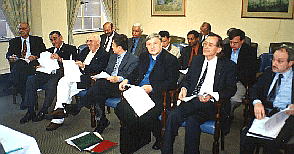 |
| Some of the attendees at the 2003 AGM. (Photo R. Zakarevicius) |
The 2003 Annual General Meeting was held on 28 November at The Castlereagh Inn, Masonic Club, 169 Castlereagh St, Sydney. The Chairman, Andrew Parfitt, reported on the activities and achievements of the year.
The Treasurer, David Tien, presented a comprehensive report that indicated that the total Section's finances are in very good shape. Chapter Chairs also presented reports on activities during 2003 and announced the results of Chapter elections.
The Chair advised the meeting that the following officers were elected for 2004 at the November Executive Committee Meeting:
-
Section Chair: Andrew Parfitt
-
Section Vice Chair: Graeme Gwilliam
-
Section Secretary: David Burger
-
Section Treasurer: David
Tien
He further advised that the following members were confirmed as the Executive Committee:
Filita Barker, Trevor Bird, Simon Boland, Ian Boyd, Stephanie Boyd, David Burger, Olly D'Souza, Steven Duvall, Karu Esselle, Eddie Fong, Graeme Gwilliam, Walter Lachs, Jim Logothetis, Stefan Mozar, Philip Ogunbona, Andrew Parfitt, Bruce Poon, Faz Rahman, Sam Reisenfeld, John Robinson, David Tien, Jim Vasseleu & Ramutis
Zakarevicius.
The meeting concluded with the presentation of the 2003 Max Simons best paper prize to Lixin Tang of the University of New South Wales (see report elsewhere in this issue) and the Region 10 Outstanding Volunteer Award to Bruce Poon (see announcement in July 2003 issue of Circuit).
Immediate Past-chair, Trevor Bird, congratulated the Chair for a successful first year as Section Chair. David Tien to the meeting, which concluded at 8 pm. An excellent dinner in Cello's Dining Room followed the meeting. Thanks to all who made this event such an enjoyable occasion?
The meeting closed at 8 pm and was followed by an excellent dinner in Cello's Dining Room. Thanks to all who made this event such an enjoyable occasion.
|
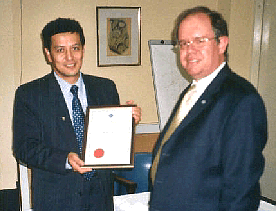
|
Bruce Poon receives the Region 10 Outstanding Volunteer Award from the Section Chair, Andrew Parfitt. (Photo R. Zakarevicius)
|

3.
NSW section officers 2004
|
2004 section
committee |
| Chairman |
Andrew PARFITT |
| Vice-chairman |
Graeme GWILLIAM |
| Secretary |
David BURGER |
| Treasurer |
David TIEN |
| Past
chairman |
Trevor BIRD |
| Membership
development |
Bruce POON |
| Awards
chair |
Jim VASSELEU |
| Fellow
search |
Walter LACHS |
| Newsletter
editor |
Trevor BIRD |
| Student
activities |
Stephanie BOYD |
| Professional
activities |
Jim LOGOTHETIS and Ian BOYD |
| Educational
activities |
Karu ESSELLE |
| Nominations
committee |
Trevor BIRD (Chair), Jim VASSELEU, Bruce POON |
| Historians |
Ramutis (Zak) ZAKAREVICIUS (Chair), Jim VASSELEU and Trevor BIRD |
| Committee
members |
Eddie FONG, Stefan MOZAR, Sam REISENFELD, John ROBINSON (Chair, Australia Council). All Chapter and Affinity Group Chairmen (ex-officio). |
| Section webmaster |
Jon Paul AGNEW |
| |
|
|
2004 chapter
committees |
|
Computer |
| Chairman |
Stephanie BOYD |
| Vice-chairman |
Ian BOYD |
| Other committee
members |
Stefan MOZAR, Phil CRAWFORD, Sean (Xiangjian) HE |
| |
|
| Communications
/ Signal processing |
| Chairman |
Ollencia DE SUZA |
| Vice-chairman |
David BURGER |
| Secretary /
Treasurer |
Philip OGUNBONA |
| Other committee
members |
Zak ZAKAREVICIUS, Sam REISENFELD, Stefan MOZAR, Simon BOLAND |
| |
|
| Antennas
& propagation / Microwave theory & techniques |
| Chairman |
Graham TOWN |
| Vice-chairman |
Andrew PARFITT |
| Secretary /
Treasurer |
Karu ESSELLE |
| Other committee
members |
Tim AUBREY, Trevor BIRD, Tony PARKER |
| |
|
| Power
engineering |
| Chairman |
Graeme GWILLIAM |
| Vice-chairman |
Mark EDMUNDS |
| Secretary |
Antony ZAGLAS |
| Treasurer |
Dan CANDOTTI |
| Other committee
members |
Vic MORGAN, Walter LACHS, Alex BAICH, Sarath PERERA (alternate of Vic GOSBELL), Trevor BLACKBURN, John KAYE, Hue OUTHRED (UNSW), Joseph ZHU, S SATHIAKUMAR, Jim VASSELEU, John ROBINSON, Jim LOGOTHETIS. |
| |
|
| Industrial
applications, power electronics / Industrial electronics |
| Chairman |
Faz RAHMAN |
| |
|
| Circuits
& systems / solid-state cicruits |
| Chairman |
Steven DUVALL |
| Secretary |
Andre van SCHAIK |
| |
|
| 2004
affinity groups |
| Life
member |
| Chairman |
Jim VASSELEU |
| |
|
| GOLD |
| Chairman |
Simon BOLTON |
| |
|

4.
Visit of IEEE President, Dr Mike Adler
The IEEE President, Dr Mike Adler, visited Sydney on 30 October as part of an Australian visit. A meeting was held at the Duxton Hotel. Mike gave a lecture and this was followed by a dinner.
|
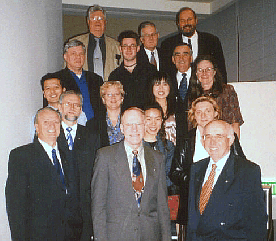
|
| IEEE President Dr Mike Adler (front centre) with NSW Section Members and guests. Clockwise from left Graeme
Gwilliam, Trevor Bird, Bruce Poon, Carol Wilson, Stefan Mozar, Ramutis
Zakarevicius, Peter Blockley, Dennis Ferrini (ACS), Sam
Reisenfeld, Jim Vasseleu, Mrs Adler, student representative, Stephanie Boyd, student representative, John Robinson. (Photo R.
Zakarevicius) |

5.
Two new IEEE Fellows from NSW elected in 2004
Two New South Wales Section members were elected Fellow of the IEEE on 1 January 2004. They are:
-
Professor Minyue
Fu, University of Newcastle,
For contributions to robust control and signal estimation; and
-
Professor Albert Y.
Zomaya, The University of Sydney,
For contributions to the solution of scheduling problems in parallel computing systems.
Congratulations are extended to both Fellows for their extraordinary achievement.
A former New South Wales Section member, Dr Graham Hellestrand, now of VaST Systems Technology Corporation, Sunnyvale, CA, was also elected Fellow, For contributions to computer system architecture simulations.
Fellow is the highest grade in the IEEE and is conferred by the Board of Directors upon a person with an extraordinary record of accomplishments in any of the IEEE fields of interest. The total number elected in any one year does not exceed 0.1% of the total voting membership.
The full list of the 260 new Fellows is available on the IEEE web site at
www.ieee.org/fellows. For the record, nominations for next year's Fellows close on 15 March 2004.

6.
Max Simons best student paper prize for 2003
|
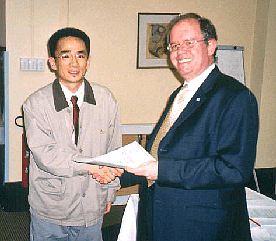
|
| Lixin Tang receives the Max Simons prize for 2003 from the Section Chair, Andrew Parfitt at the AGM on 28 November 2003. (Photo R.
Zakarevicius) |
Each year the NSW Section awards a prize for the best paper submitted by a student for the Section or Region 10 Competitions. The NSW Section prize is named in honour of Max Simons the first Chair of the Australia Council and foundation member of the NSW Section Committee. In 2003, the Max Simons prize was awarded to Mr Lixin Tang, a postgraduate student at the University of New South Wales, for the paper entitled "A Speed Sensorless, Direct Torque Controlled Interior Permanent Magnet Machine Drive with Low Ripples in Torque and Flux". All papers submitted for the competition in 2003 were of a high standard, which made selection of a winner difficult. What was notable about Lixin's paper was its originality, development of the concepts, the use of references and the quality of the background review. Of significance was the presentation of both theory and experimental data and the good agreement obtained between the two. Lixin was presented with a certificate and $200 cash by the NSW Section Chair, Andrew Parfitt, at the Annual General Meeting on 28 November 2003.

7.
Free membership offer to new student members from NSW
There are significant benefits of being a member of IEEE and especially for student members. In 2004, the IEEE NSW Section is once again this year offering up to 200 free memberships to students in their second or higher year of a recognised Electrical Engineering/Computer Science degree course at universities in New South Wales who are not already members of IEEE. If you are eligible, or you have friends who are, and you/they wish to take up this offer, print the Student Membership form from the web or request a form from David Burger, the Section Secretary. The student member application form can be downloaded in PDF format online
by clicking
here. You should complete the form and then send it with your email address to:
David Burger,
Secretary IEEE NSW Section,
C/- Australian Professional Centre,
Private Bag 1, Darlinghurst NSW 2010.
The IEEE NSW Section will fund the first 200 valid applications received.
This offer closes on 31 March 2004. You will be notified by email whether your application has been accepted. No correspondence will be entered into on unsuccessful applications.

8.
New senior members from NSW section
Congratulations are extended to recently-elected Senior Members from NSW. These include David J. Skellern, Ian Davis, David B. Lowe and Yi Mu.

9.
The web helps us keep in touch with you
The Section web site is now the main way of keeping members in New South Wales informed. The Web Master, Jon Paul Agnew
(jpagnew@ozemail.com.au), maintains this resource for the Section. Place the web address
(ewh.ieee.org/r10/nsw) in your bookmarks so as to keep up to date with the latest Section news and information.
Click on 'News' for updates to the lecture programs on the NSW Section web site. Electronic copies of this and past issues of Circuit can also be downloaded from the website.
Notifications of social and networking functions, technical meetings, notification of new issues of Circuit and other IEEE electronic publications all come to you via the Internet.
If your email address changes, please notify IEEE through the membership update area of the IEEE web site. Go to www.ieee.org then click on 'Membership'.
Please advise the Membership Officer, Bruce Poon, email adsphere@mpx.com.au
or ph. 9831 8412, if your email address is up to date with IEEE but you are not receiving emails from the NSW Section or NSW Chapters.
IEEE also provides a valuable way for you to keep the same email for those people and organizations you want to stay in touch with, even after your job or service provider changes. Register for a personal email alias
name@ieee.org. If you then insert this alias at the member update area, you will overcome the need to notify the IEEE if your email changes. The IEEE alias service is FREE and also provides Virus Scanning. To obtain an email alias go to the IEEE website
(www.ieee.org), click on 'Membership' in the menu to the left. Next click on 'Update your IEEE Email alias' and follow the directions from there.

10.
Become an IEEE senior member
Some of our members have recently enjoyed the benefits of IEEE Senior Membership. Many other members of the NSW Section are also eligible for Senior Membership. Anyone with ten years in the profession (not ten years of IEEE membership) is eligible. Your educational experience is counted towards this ten-year requirement. In addition, you need five years of significant performance and three IEEE Senior Member or Fellow references. If you are nominated, only two references are needed. As well as recognizing your performance and contribution to the profession in a tangible way, each new Senior Member receives an attractive fine wood and bronze engraved Senior Member plaque and a US$25.00 gift certificate towards one new Society membership.
Now it is even easier to become a Senior Member via the IEEE website. Details and application forms are obtained at
www.ieee.org/organizations/rab/md/smprogram.html.

11.
Useful IEEE web addresses
Increasingly, the IEEE is relying on the Internet to deliver services to members. Some useful web addresses are summarised below for your information.

12.
Joint technical meetings for 2004
All members are invited to attend the listed joint meetings with the I.E. Aust., ITEES and IEE. All meetings are held at 5.30 for 6.00 pm (with light refreshments) at the Institution of Engineers, Australia Lecture Theatre, Eagle House, 118 Alfred St, MILSONS POINT, unless otherwise shown.
| DATE |
SUBJECT |
SPEAKER |
SPONSOR |
| 12
Feb |
Australian Communications Authority: Business Cabling and Regulation |
Ray Bradford & Ian McAlister, Australian Communications Authority |
IEAust |
| 26 Feb
|
Solving EMI/EMC Switched Mode Problems
|
S. Mozar
|
IEEE
|
| 11 Mar |
Personal Broadband |
Jonathan Withers, Personal Broadband Australia |
IEAust |
| 25 Mar |
The Proposed NSW Solar Tower |
Roger
Davey, EnviroMission |
IEE |
| 15 Apr |
Precision Location Technology and Applications |
Dr. Paul Axon, CSIRO |
IEE |
| 29 Apr |
Machine Learning Techniques |
Dr. David Rees, CSIRO |
IEE |
| 13 May |
The Bass Link Project |
TBA |
IEAust |
| 27 May |
Advances in Speech and Audio Processing |
Dr. E. Ambikairajah, UNSW |
IEEE |
| 10 Jun |
Update on Photovoltaic Solar Energy Conversion |
Prof. Martin Green, UNSW |
IEEE |
| 24 Jun |
Topic to be advised |
Mark Bezzina, Standards Aust |
IEAust |
| 08
Jul |
Ageless Aerospace Vehicles |
Dr. Don Price, CSIRO |
IEE |
| 22 Jul |
Artificial Photosynthesis |
Dr. Tony Collings, CSIRO |
IEE |
| 12 Aug |
Topic to be advised |
TBA |
IEAust |
| 26 Aug |
Biometrics and Security |
Dr. Geoff Poulton, CSIRO |
IEAust |
| 09 Sep |
Adaptive Wireless Systems |
Dr Colin Jacka, CSIRO |
IEAust |
| 23 Sep |
Nanotechnology |
Dr. Burkhard Raguse, CSIRO |
IEE |
| 14 Oct |
Condition Monitoring of XLPE Insulated Cables |
A/Prof. Trevor Blackburn, UNSW |
IEEE |
| 28 Oct |
Millimetre-wave
(MMW) devices for emerging applications in telecommunications and radar |
A/Prof Tony Parker, Macquarie Uni. |
IEEE |
| 11 Nov |
Building the New ANSTO Nuclear Reactor |
TBA |
IEAust |
| 25 Nov |
The New Haymarket 330 kV Substation |
Chris Fitzgerald, TransGrid |
IEAust |
| 26 Nov |
IEEE Annual General Meeting |
|
IEEE |

13.
Details of upcoming joint technical meetings
AUSTRALIAN COMMUNICATIONS AUTHORITY, BUSINESS CABLING & REGULATION
Thursday, 12 February 2004
Speakers: Ray Bradford & Ian McAlister, Australian Communications Authority
Synopsis: The Australian Communications Authority (ACA) will provide industry members with information about the current regulatory requirements of people who install and maintain telecommunications cabling in homes, offices and other premises. The ACA is the Government regulator for telecommunications and is keen to ensure that all cablers, cabling contractors and employers who undertake telecommunications cabling work understand their legal obligations and responsibilities under the Cabling Provider Rules and the new industry code: Cabling requirements for business. Members are also welcome to ask questions about the broader role of the ACA as industry regulator, including general information on industry codes in the telecommunications regulatory environment.
Biography: Ray Bradford, Customer Cabling & Access Team, is responsible for developing policy with respect to regulation of customer cabling, including administration of the cabler registration system, technical standards, compliance and the industry code - Cabling requirements for business.
Ian McAlister, Manager Radiocommunications Standards Team, is responsible for administering the technical standards and compliance regimes for electromagnetic radiation, electromagnetic compatibility, radiocommunications and telecommunications.
SOLVING EMI/EMC PROBLEMS IN SWITCHED MODE POWER SUPPLIES
Thursday, 26 February 2004
Speaker: Stefan Mozar
Synopsis: This talk covers the practical aspects of solving EMI/EMC problems in switched mode power supplies. It will begin with a brief overview of basic EMI/EMC issues. This will be followed by what type of test equipment is recommended. It will cover how a spectrum analyzer can effectively aid in pinpointing EM problems. The application of sniffer probes will be discussed in identifying magnetic-field and electric-field problems. The talk will describe, with the aid of a case study, how EM problems can be solved in a power supply and issues when designing switching power supplies. Issues covered are EMI filters, rectifiers, snubber circuits, switching devices, the switching transformer, PCB layout techniques. The selection of components for reducing EM problems and various trade offs will also be covered.
Biography: Stefan Mozar is an electronics engineer with many years experience in the design of switched mode power supplies. His talk will be based on work undertaken for Philips in their Singapore Video Development Laboratory, where he was a chief engineer responsible for large signal design of television receivers and for solving EMI/EMC problems.
PERSONAL BROADBAND
Thursday, 11 March 2004
Speaker: Jonathan Withers, Personal Broadband Australia
Synopsis: Personal Broadband Australia (PBBA) has deployed the innovative iBurst technology in Sydney, creating the world's first commercially operating iBurst broadband network. The service provides wide-area, wireless, broadband IP connectivity to mobile terminals and, at the same time, achieves a spectral efficiency that is unsurpassed by any other cellular technology. More than just a technology adaptation, iBurst has been designed from the ground up, taking a fresh look at the radio propagation environment and creating a system specifically attuned to data communications. At the heart of the system lies the use of 'smart' antennas and some sophisticated digital processing which allows some of the traditionally-accepted constraints in mobile communications to be overcome. This talk will outline the background to PBBA's selection of technology, frequency spectrum, results of the field trials, the implementation of commercial services and the engineering challenges involved.
Biography: Jonathan Withers is PBBA's Chief Technical Officer. He leads the deployment of the PBBA network in Australia and is responsible for all technical operations. Prior to joining the Company, Mr. Withers was a director with Vodafone Pacific in charge of technical strategy including future technology selection. Mr. Withers initially led the radio network deployment for the GSM system in Australia. Prior to Vodafone, Mr. Withers was based in the United Kingdom with Motorola and was instrumental in defining the radio access specification for GSM in the late '80's.
OTHER LISTED MEETINGS
No details of the other listed meetings have been provided at the time
of printing this newsletter. Please visit the 'News'
page of the Section web site for details in the weeks preceding the
meeting.

14.
IEEE sponsored conferences
Details of conferences and other forthcoming international events can be found by visiting the IEEE web site
www.ieee.org/conferencesearch/.

15.
Power engineering chapter news
Following the 2003 AGM in November, the elected officers for 2004 are the same as for the previous year (see list elsewhere in this issue). At this stage, the 2004 program will follow along similar lines to that of 2003.
Graeme Gwilliam
Chair

16.
Antennas & propagation / Microwave theory & techniques
chapter news
Two excellent talks were given at the end of last year by Graham Town ("Broadband optical fibre systems" and Andrew Parfitt ("FedSat - 12 months and going strong"). The AGM in November elected a new Committee with Graham Town as the Chair in 2004. The Committee members are listed elsewhere in this issue.

17.
IEEE President-elect to present IEEE Presidents' scholarship
On 13 May 2004, IEEE President-elect W. Cleon Anderson will present the $10,000 IEEE Presidents' Scholarship at the annual Intel International Science and Engineering Fair (ISEF) held this year in Portland, Oregon. The IEEE Foundation funded $10,000 Scholarship is awarded for 'outstanding achievement in creating a project that demonstrates an understanding of electrical engineering, information technologies, or other IEEE fields of interest'. It is the largest award given by an organization at the Special Awards Ceremony at the Intel ISEF. The Scholarship, which is in its sixth year, is the only IEEE-wide scholarship awarded to high school students. For more information on the Scholarship and the Fair, go to
www.ieee.org/eab/precollege/scholarship/
or contact Sasha Eydlin at s.eydlin@ieee.org.

18.
IEEE virtual museum continues to gain visitors
Designed to teach the general public-and particularly the pre-university crowd-about IEEE technologies and their social and historical importance, the IEEE Virtual Museum (VM), which opened in 2002, continues to draw thousands of users monthly and to attract critical praise. The newest exhibit, Women & Technology, opened in June 2003 to rave reviews. The two most recent awards for the VM were to be named one of the 'Best Sites for Kids' by the prestigious American Library Association and to make PC Magazine's 'Top 101' list. PC Magazine named the IEEE VM one of the "Top 101 Most Incredibly Useful Sites" of 2003. The museum was among the eight sites chosen in the 'Computing - Everyone' category. The review called it a 'fascinating, engaging, image- and infographic-laden site' where 'you'll discover the stories behind your favorite electrical engineering marvels'. For more information on the list, go to
https://www.pcmag.com/category2/0,4148,7488,00.asp.
You can visit the IEEE Virtual Museum yourself at https://www.ieee.org/museum.
Be sure to look for the next exhibit on technology and World War II, opening in December 2003.

19.
History of Circuit's masthead
The origin of the masthead on this issue of Circuit has an interesting history involving the early committee of the NSW Section. Prior to Circuit, and after the formation of the Australian Section in 1972, there was a newsletter called 'NEWS'. According to Jim Vasseleu's recent recollections, in late 1976, Max Simons, Alan Rister and Jim met in Alan's office at the Royal North Shore Hospital to discuss an alternative to the newsletter. The result was Circuit with a masthead based on a printed circuit board. Alan had the drawing done and from 1977 onwards IEEE NSW has used this design as our masthead.
Just a little background to the people involved, Max Simons was the SCADA Project Manager for Leeds and Northrop, Alan Rister was the Maintenance Manager at RNSH, and Jim Vasseleu was Electrical Engineering Director of Fowell, Mansfield, Jarvis and Maclurcan, Architects and Engineers, Neutral Bay. For the first 10 years of the IEEE operation in NSW, the Section Committee meetings were held in Jim's office.

20.
Successful consumer electronics conference held in Sydney
The International Symposium on Consumer Electronics (ISCE03) was held in Sydney from 2 to 5 December 2003. It was the first time this prestigious symposium, which brings together delegates from all over the world, was held in Australia. The ISCE03 was originally going to be held in Singapore. However, due to the SARS crisis in Asia, the international advisors and the organizing committee decided to relocate the symposium to Sydney. This Symposium was a good example of international collaboration.
The program started with two well-attended tutorials on the 2 December. Dr Scott Linfoot and Dr Simon Sherratt, both from the University of Reading, UK, conducted the first tutorial. The title of the tutorial was "An Overview of DTV and DTV Middleware". Assoc. Prof. Wu from Monash University, Australia presented the second tutorial. The title was " Perceptual Quality Assessment and Coding for Digital Video and Images." The next day saw the official opening of the Symposium by the Consumer Electronics Society's President Ralph Justus. Mr Justus is also the Vice President for Technology & Standards of the Consumer Electronics Association, USA. He delivered a Keynote speech on "Converging Technologies and Connectivity: The challenges of speaking digital without an analog accent". During the opening ceremony, Outstanding Service Awards were presented to Assoc. Prof. Nicholas Vun (Singapore), Assc. Prof. Robin Bradbeer (Hong Kong), Prof. Hang (Taiwan), Prof. Weissleder (Germany) for their contributions toward the ISCE over many years. After the opening ceremony the presentation of over 100 papers began. These papers covered a full range of topics from the vast field of knowledge known as consumer electronics. This was an excellent program with something for everybody. The Symposium offered plenty of opportunities to network and exchange ideas.
One of the highlights of the Symposium was the conference dinner, which was held on a cruise on beautiful Sydney Harbor. During this cruise the Engineering Excellence Award was presented to Bob Frankston for his pioneering work on Home Networking. Bob Frankston is better known for his work with Dan Bricklin as the inventor of the electronic spreadsheet. The list of past recipients reads like a Who's Who of Electronics, with names like Sim Wong Hoo of Creative Technologies, Ray Dolby, Vint Cerf, Prof. Brandenburg and Prof. Reimers to name a few.
The Singapore Committee hosted the International Chapter Chairs to dinner in China Town, where strategies for future CE Society activities were discussed. Prof Weissleder was elected as the new ISCE President. In this role he will coordinate the activities for the ISCE and liaise with the international chapter chairs in organizing future hosts.
Congratulations are due to the Singapore Organizing committee for organizing an excellent Symposium. The next symposium will be held in Reading, England. Further information on the ISCE04 is available at:
isce@reading.ac.uk. Don't miss the opportunity to be there!
Stefan Mozar

21.
Report on DICTA 2003
The VIIth Australian Pattern Recognition Society (APRS) conference on Digital Image Computing: Techniques and Applications, was held in Sydney, Australia from 10 to 12 December 2003. The APRS is a scientific community which has been able to establish DICTA as the major regular conference for image-related fields in Australia. CSIRO involvement and partnership together with sponsorships and IEEE endorsement ensured the success of the event. Previous DICTA conferences were held in 1991, 1993, 1995, 1997, 1999, and 2002.
We received 155 submissions, a significant proportion of which were from overseas, and an exhaustive round of reviews was initiated. This year, 108 papers were accepted and published in both paper and CD format, as well as on the Web at no cost. Authors also retain the copyright of their work and may post their papers on their own web site if they wish.
This year for the first time, DICTA was combined with ANZIIS, the Australia-New Zealand Intelligent Information Systems conference. There are obvious synergies between the two communities, and it is through the vision of Anthony Maeder and Brian Lovell that this was made possible. Both DICTA and ANZIIS proceedings are available on the CD-ROM.
A total of 261 authors and co-authors make up contributions, in addition to the five internationally recognized invited speakers: Professor Nicholas Ayache (INRIA, France), Richard Hartley (ANU, Australia), Henk Heijmans (CWI, Netherlands), Thomas Huang (UIUC, USA), and Ray Jarvis (Monash, Australia). The program format enabled all delegates to attend each invited speaker presentation, followed by two parallel streams for DICTA and two for ANZIIS as well as poster sessions on topics as diverse as Image Processing, Face Recognition, Segmentation, Registration, Virtual Environments, Graphics, Motion, Medical Imaging, Object Recognition, Stereo and Video Analysis. Further information is given on the DICTA 2003 web site at:
www.tip.csiro.au/dicta2003/index.html
Tony Adriaansen
Co-chair, DICTA2003 Conference.

22.
Order of Australia to Philip Dulhunty
Congratulations to Philip Dulhunty, a long-time member of IEEE NSW and the Power Engineering Chapter on his Order of Australia award in January. Philip was a co-founder of Dulmison, a business well known in the power transmission industry. In later years he established Dulhunty Industries, which he continues to run, that is, in between his flying boat excursions.
Graeme Gwilliam

23.
Member Profile - Trevor Bird
|
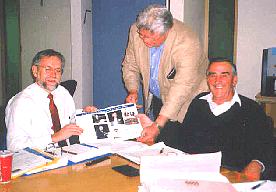
|
| Trevor Bird (left) is congratulated by 'Zak' Zakerevicius (centre) and Jim Vasseleu at the November 2003 Section Executive meeting, on being awarded 'Engineer of the Year' in 2003 by the Institution of Engineers, Australia, Sydney Division. |
Dr Trevor Bird is the Editor of Circuit and immediate-past Chair of the NSW Section. He has been a member of the Section Committee since 1994. Currently, he is an Associate Editor of the IEEE Transactions on Antennas & Propagation and an elected member of IEEE Transactions on Antennas & Propagation Society Administrative Committee till 2005. Recently, he was appointed Chapter Coordinator for the Antennas & Propagation Society.
Trevor has worked for CSIRO for just over 20 years, and currently is a Chief Research Scientist and Research Leader of the Electromagnetic Information and Intelligent Systems in the CSIRO ICT Centre. Prior to joining CSIRO, he spent five years as a Lecturer in the Department of Electrical Engineering at James Cook University of North Queensland. During 1982 and 1983 he was a consultant at Plessey Radar, UK. He graduated with B. App. Sc., M. App. Sc. and PhD degrees from the University of Melbourne in 1971, 1973 and 1977 respectively. From 1976 to 1978 he was a Postdoctoral Research Fellow at Queen Mary College, University of London.
Trevor has published widely on antennas and microwave systems for satellite communications, wireless and radio telescope systems. He is known internationally for his contributions to reflector antennas, multiple beam antennas, and arrays. Some projects he has worked on have resulted in operational antenna systems on Optus-B, Galaxy IV and Orion satellites, earth stations for the Australian Department of Defence and Telstra. He has guided development of CSIRO's MultiBeam earth station antenna, designed innovative multibeam feed arrays for the Parkes, Jodrell Bank (UK) and Arecibo (US) radio telescopes, instigated development of the novel Ka-band transponder on the FedSat microsatellite and participated in the development of antennas for millimeter-wave indoor wireless local area networks.
Trevor is a Fellow of the Academy of Technological and Engineering Sciences, the IEEE, the Institution of Engineers, Australia, the Institution of Electrical Engineers, and is an Adjunct Professor at Macquarie University, Sydney. He was a Distinguished Lecturer for the IEEE Antennas & Propagation Society from 1997 to 1999, Chairman of the IEEE Antennas & Propagation/Microwave Theory & Techniques Chapter of New South Wales, Australia, from 1995 to 1998, Chairman of the 2000 Asia Pacific Microwave Conference, and Chairman of the IEEE New South Wales Section from 2001 to 2002.
He received the John Madsen Medal of the Institution of Engineers, Australia in 1988, 1992, 1995 and 1996 for the best paper published annually in the Journal of Electrical and Electronic Engineering, Australia, and in 2001, he jointly received the H.A. Wheeler Applications Prize Paper Award of the IEEE Antennas & Propagation Society. He was awarded a CSIRO Medal in 1990 for the development of an Optus-B satellite spot beam antenna, and again in 1998 for the multibeam antenna feed system for the Parkes radio telescope. In 2000, he received an IEEE Third Millennium Medal for outstanding contributions to the IEEE New South Wales Section. In 2003, he was awarded the Centenary Medal for contributions to Telecommunications and named Professional Engineer of the Year by the Sydney Division of Institution of Engineers, Australia.

24.
Engineering excellence award for FedSat
|
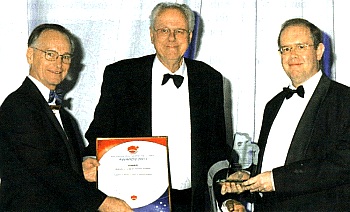
|
| 2003 Engineers Australia President, Dr Peter Greenwood (left) presents the Excellence Award to Tony Staley (centre) Chairman and Dr Andrew Parfitt (right) CEO of the Cooperative Research Centre for Satellite Systems. (Courtesy Engineers Australia) |
The Cooperative Research Centre for Satellite Systems received a National Engineering Excellence Award in 2003 for design, manufacture, launch and test of FedSat, the first indigenous Australian satellite in more than 30 years. FedSat was launched on 14 December 2002 by Japan as a gift for Australia's Centenary of Federation. The 60kg satellite carries four primary experiments in communications, reconfigurable computing, ionospheric sounding and earth magnetic field monitoring. FedSat is a complex microsatellite and, as well as being assembled and tested in Australia, a significant proportion of the components, software and test equipment was manufactured here also. It is notable that IEEE members in New South Wales, ACT and South Australia played a prominent part in the development of FedSat and the current New South Wales Chair, Andrew Parfitt, is the CEO of the CRC for Satellite Systems. Andrew took over form the inaugural CEO, Brian Embleton, in March 2003. FedSat has been in operation for over 12 months and all payloads are operating successfully. This is truly a remarkable achievement when you consider that the major payload, Adeos II, which was launched with FedSat, failed during the high solar flare and wind activity late last year. FedSat is expected to provide significant data throughout its design life time of three years.

25.
Dish designer Harry Minnett passes
|
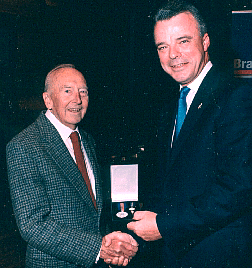
|
| Harry Minnett receives the Centenary Medal from Dr Brendan Nelson, Minister for Education, Science and Training, in 2003. |
Life Member of IEEE Harry Minnett, a former Chief of the CSIRO Division of Radiophysics and designer of the Parkes radio telescope ('the Dish'), died on 20 December 2003 at the age of 86 after a short period of illness.
Harry was born in Hurstville on 12 June 1917, educated at Sydney Boys High School and Sydney University where he graduated with a double degree in Physics and Engineering.
He joined the CSIR (now CSIRO) Radiophysics Laboratory in 1940, during the Second World War, to work on the development of radar. After the War, he became part of the group in the Radiophysics Laboratory that was involved in the early stages of Radio Astronomy and that built Australia's early reputation in this field. Harry was project manager for the design and construction of the Parkes radiotelescope in the late 1950s to early 1960s. Harry's very important contributions were the development of the servo control that was used with the master equatorial guidance system and the antenna geometry, both of which have contributed to the longevity of the antenna as a research instrument. After this period with the Parkes Telescope, Harry was the Group Leader for Antenna Research in the Radiophysics Laboratory and he was a Consultant to the Jet Propulsion Laboratory during the design of the Tidbinbilla 64 metre antenna for the deep space network. Harry subsequently became a Consultant and project manager on the construction of the Anglo-Australian Optical Telescope. After his period working on the Anglo-Australian Telescope, Harry returned to the Division and became the Engineering Director of the Interscan Project, a project to develop a microwave landing system. Harry became Chief of the Division of Radiophysics in 1977 until he retired in 1981. During this time, Harry played a key role in the early stages of development work for the antennas for the Australia Telescope and in promoting the development of Australian technology so that the work could be done locally. He was awarded the Order of the British Empire - Officer (Civil) in 1972 and the Centenary Medal for service to Australian society and to the science of radiophysics in 2003.
The IEEE extends its condolences to Harry's son Adam and daughter Kate.
(Based on an obituary prepared for the Academy of Technological Sciences & Engineering by R.H. Frater & T.S. Bird.) 
26.
If you want to continue to receive circuit by mail please download and
complete the form
Except for the July issue, Circuit will normally be provided electronically by downloading from the NSW Section Web site
https://ewh.ieee.org/r10/nsw. Members will be notified by email using the address provided at the membership renewal time when a new issue has been posted on the web site.
Circuit will be mailed only to those members requesting a printed copy or those not having an email address. If you require a hard copy of CIRCUIT mailed to you please complete the form
and return to the Editor at the address shown. To download the printable form,
please click here. 
|